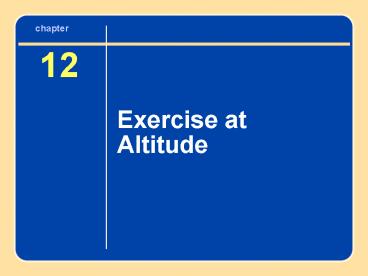Presentation Package PowerPoint PPT Presentation
1 / 20
Title: Presentation Package
1
chapter
12
Exercise at Altitude
2
Learning Objectives
- Find out what conditions in hypobaric
environments (at altitude) limit physical
activity - Learn the physiological adjustments that
accompany acclimatization to altitude - Discern whether an endurance athlete who trains
at altitude can perform better at sea level
3
Conditions at Altitude
- At least 1,500 m (4,921 ft) above sea level
- Reduced barometric pressure (hypobaric)
- Reduced air temperature
- Decreased water vapor pressure
- Increase in solar radiation intensity
4
Differences in Atmospheric Conditions at Sea
Level up Through an Altitudeof 9,000 m (29,520
ft)
5
High Altitude Environments
- Key Points
- Altitude represents a hypobaric environment
- Percentages of gases remain constant but the
partial pressures of the gases decrease - Air at altitude is dry
- Because the atmosphere is thinner and drier,
solar radiation is more intense, which is
magnified by snow cover
6
Reductions in PO2 and Endurance Performance
- The reduction in PO2 at altitude affects the
partial pressure gradient between the blood and
the tissues and thus oxygen transport. This
explains the decrease in endurance performance at
altitude.
7
Cardiovascular Responsesto Altitude Cardiac
Output
- Cardiac output is increased at rest and during
submaximal exercise - Acute exposure results in a decrease in stroke
volume and an increase in heart rate - Increase in HR and cardiac output peaks after
6-10 days at altitude
8
Metabolic Responses to Altitude
- Basal metabolic rate increases
- Increased thyroxin and catecholamines
- Acute decline in appetite
- Increased reliance on carbohydrates for fuel at
rest and during exercise - Lactate paradox
9
Cardiovascular Responses to Altitude
- Key Points
- There is a decreased PO2 throughout the body
- With acute altitude exposure, pulmonary
ventilation increases, pulmonary diffusion is
maintained, but oxygen transport is slightly
impaired - Oxygen uptake by the muscle is impaired due to a
reduced diffusion gradient - Initially, decreased plasma volume increases red
blood cell concentration, allowing more O2 to be
transported per unit of blood
(continued)
10
Cardiovascular and Metabolic Responses to
Altitude (continued)
- Key Points
- Initially, cardiac output during submaximal work
increases to compensate for decreased O2 content
through an increase in heart rate - During maximal work, stroke volume and heart rate
are lower, resulting in decreased cardiac output - Oxygen delivery and uptake are impaired
- Metabolic rate increases by increased sympathetic
nervous system activity - Increased reliance on carbohydrates for fuel
during rest and exercise
11
Changes in Maximal Oxygen Uptake With Decrements
in Barometric Pressure and Partial Pressure of
Oxygen
- Data from E.R. Buskirk et al., 1967, "Maximal
performance at altitude and on return from
altitude in conditioned runners," Journal of
Applied Physiology 23 259-266.
12
Anaerobic Sprinting, Jumping,and Throwing
Activities
- Anaerobic sprint activities lasting less than a
minute or two are not impaired - Sprinting, jumping, and throwing activities might
be improved due to the thinner air and less
aerodynamic resistance to movement
13
Exercise and Sport Performance at Altitude
- Key Points
- Prolonged endurance performance suffers the most
at high altitude because oxidative energy
production is limited - VO2max decreases in proportion to the decrease in
atmospheric pressure - Anaerobic sprint activities lasting lt 2 minutes
are not impaired at moderate altitude - Sprinting, jumping, and throwing activities might
be improved due to the thinner air and less
aerodynamic resistance to movement
.
14
Acclimatization to Altitude Pulmonary and Blood
Adaptations
- Pulmonary adaptations
- The increased resting ventilation rate levels off
at a value 40 higher than at sea level - Submaximal exercise ventilation rate plateaus at
50 higher - Ventilation during exercise remains elevated at
altitude and is more pronounced at higher
intensities - Blood adaptations
- ? Number of red blood cells, polycythemia
- ? Plasma volume
- ? Hemoglobin content
- ? Oxygen-carrying capacity
15
Hemoglobin (Hb) Concentrationsof Men Living at
Various Altitudes
16
Acclimatization to Altitude Muscle and
Cardiovascular Adaptations
- Muscle adaptations
- Decrease in muscle fiber cross-sectional area and
total muscle - Reduced mitochondrial and glycolytic enzyme
activities - Increased capillary supply
- Cardiovascular adaptations
- Decrease in VO2max with initial exposure and does
not improve with continued exposure
.
17
Acclimatizationto Altitude Adaptations
- Key Points
- Hypoxic conditions stimulate red blood cell
production - Overall there is an increase in total blood
volume and an increase in oxygen-carrying
capacity - Muscle mass and total body weight decrease as a
result of dehydration, appetite suppression, and
protein breakdown in muscles - Muscle adaptations include decreased fiber area,
increased capillary supply, and decreased
metabolic enzyme activities - Work capacity improves but the decrease in VO2max
does not improve
.
18
Altitude Training for Sea-Level Performance
- Increases red blood cell mass on return to sea
level - Existing research does not support the assertion
that altitude training improves sea-level
performance - Difficult to study since intensity and volume of
training are reduced at altitude - Live at moderate altitudes and train at low
altitudes, where training intensity is not
compromised
19
Living High, Training Low
Improvements in race time in elite male and
female runners and college male and female
runners following four weeks of living at
altitude but training at 1,250 m
20
Training for Optimal Altitude Performance
- Compete within 24 hours of arrival at altitude
- Train at 1,500 to 3,000 m above sea level for a
minimum of 2 weeks before competing - Increase VO2max at sea level to be able to
compete at a lower relative intensity
.

